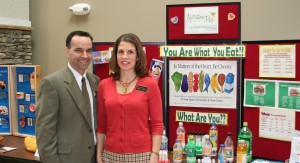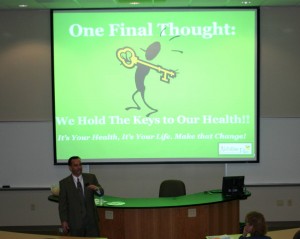| |
 |
Archive for Nutrition
April 7, 2009 at 1:56 pm
· Filed under , General Nutrition & Wellness, Nutrition, Professional Interest
Wow! We just completed a very successful National Nutrition Month! March kept us busy as we celebrated Nutrition Month with the Elizabeth City community. Take a look:
Monday March 2nd – John and I provided a Nutrition Presentation for the P.W. Moore Elementary faculty members. We followed this with a “Wellness Wednesday” nutrition and fitness tip each Wednesday during the month that was read during the morning announcements.
Monday March 16th: Angie presented a Nutrition Presentation to twenty five girls between the ages of 8 and 12 at Girls, Inc. in Elizabeth City.
Friday March 20th: John joined host Sheila Lee for the “Morning Joy” gospel radio show on ECSU radio WRVS 89.9.
Tuesday March 24th: John and I participated in a radio interview in which we talked about the role of nutrition in chronic disease prevention with Letitia Evans on ECSU radio 89.9 WRVS. (A special thank you to Host Greg Sampson for giving our son a tour of the station and allowing him to do his homework at your desk! He is loving the “Parliament” CD!).
Thursday March 26th: John presented “Just Give me the Facts: the Nutrition Facts” for the Elizabeth City State University Drug Information Center.
Saturday March 28th- Angie exhibited and participated in the “Ask the Expert” forum at “Diabetes Day: A Three Rivers Healthy Carolinians Conference for People with Diabetes” at Edenton Baptist Church, Edenton, NC.
Tuesday March 31st: Nutrition Pair (John and Angie with the help of our fellow RD/CDE, Kelly McCombs) exhibited at the Elizabeth City Chamber of Commerce Business Expo.
Here’s to a great month! We’re looking forward to the 2010 celebration!
It’s Your Health! It’s Your Life! Make That Change!
~ Angie
Permalink
January 27, 2009 at 9:41 pm
· Filed under Nutrition
When we talk to clients about nutrition, there always seems to be some misinformation or misconceptions floating around. We try to make things easier to understand. There is no need to make nutrition more complex than it already is! What I have tried to do today is break it down into easy to remember guidelines. To get the most out of Nutrition For Your Health, remember the 5 Fs & 1 V:
F #1: FATS~ Use your food label to monitor the type and amount of fats in your food. The two main fats to be concerned about are Saturated & Trans Fats. These fats have been shown to be the most damaging fats to the body. They are responsible for raising cholesterol levels and increasing your risk for heart disease. Daily intake levels vary but a general guideline would be for women to keep Saturated & Trans fats, combined, to no more than 12-14 grams a day. Men should keep their intake to no more than 15-17 grams a day. Remember, these numbers will vary according to your individual needs. Foods high in Saturated fats include: Beef, Pork, dark meat of chicken & turkey, cheese, 2% or Whole Milk, butter,ice cream, chocolate bars, fried foods & many fast food choices. High Trans Fats Foods include many commercially baked goods such as cookies, cakes, pies, & donuts, many fast food choices. (Since food companies were required to list trans fats on the food label in 2006, it is interesting to note the number of foods that are now “Trans Fat free”!!)
F#2: FISH~We have already discussed the fact that beef & pork are high in saturated fats. Fish is extremely low. Even the leanest cuts of beef & pork are still high in saturated fats. The benefits of fish go beyond just the fat content. In fact, fatty fish such as Salmon & mackerel are recommended for their unsaturated fat content. It has been stated that eating ~6 oz of Salmon a week will provide you with a therapeutic range of Omega 3 fatty acids. That can help you control cholesterol levels and protect your heart. Eating more fish does not mean that you stop at your local fish fast food place or grab the fish stix out of the freezer section in the grocery store. Those choices tend to be high in saturated/trans fats and lower in the beneficial fats your body needs. They are also much higher in sodium! You can find affordable salmon choices in your local grocers freezer section. You can also use canned varieties as well. Remember, you want to bake, grill, steam or boil your seafood. Breading & frying tends to take us back to the high fat foods we’re trying to reduce. Check out some recipes here!
F#3 + a V: FRUITS & VEGETABLES~ These two food groups continue to be the most overlooked foods on our list. We know they are low in fat & calories but we continue to under eat them. These foods provide our bodies with numerous vitamins & minerals. They are referred to as “Natures Perfect Supplement”. Increasing your intake of these foods can not only help you control weight, blood sugars and cholesterol levels, they can also help you lower blood pressure. When patients are told by their doctors that they have high blood pressure, they are usually prescribed medications and told to avoid salt or sodium. If you simply increase your intake of fruits and vegetables you can significantly lower your blood pressure….regardless of whether or not you lower your sodium intake. If you do lower your sodium intake along with increasing fruits & vegetables, blood pressure levels drop even further. The other benefit of increasing Fruits & Vegetables, it helps to increase your FIBER intake.
F#4: FIBER~We are all aware that increasing fiber can help with regulating bowel movements. But did you know that increases in Fiber can also help to lower cholesterol level? Fiber will bind with cholesterol in the gut and help to remove it. By eating more fruits & vegetables, whole grain breads and cereals, and adding dried beans & lentils to your daily intake you can easily reach the goal of 25-35 grams of fiber a day. Read your food labels to determine the exact amount of fiber in your favorite foods.
F#5: FUN!~Remember, you have to enjoy life. Sharing a meal with others is about more than just eating the food. We also benefit from the personal interactions. Don’t focus on what you “can’t have” but rather on the good things you can have. Find new ways to add more fun to your life. It has often been said that, “Laughter is the best medicine!” Focus on the positive choices you’ve made and keep moving forward!
So there you have it the 5F‘s and a V for better health:
1. Know your FATS
2. Eat more FISH
3. Increase your FRUITS & VEGETABLES
4. Check your FIBER
5. Have FUN!
It’s Your Health. It’s Your Life. Make That Change!
~Johnikoni
Permalink
January 19, 2009 at 2:05 pm
· Filed under General Nutrition & Wellness, Nutrition, Professional Interest, Wellness
Nutrition Pair participated in the North Carolina State Medical Assistants (NCSMA) Winter Seminar, “Bridging the Gap to Healthcare” held January 17th at College of the Albemarle here in Elizabeth City. There were 86 medical assistants from across the state in attendance.
We exhibited at the conference and John provided the nutrition presentation “Discovering Your Path to Wellness”. In it, he reviewed the current health of our nation as well as that of North Carolina. For example, in North Carolina, 61% of adults are overweight or obese and 27% of adolescents are either overweight or at risk of becoming overweight (CDC, 2003). Focusing on the health risks associated with poor lifestyle choices, John discussed ways for the attendees to improve their own health as well the health of their patients. He stressed how important it is that we serve as healthy role models for our clients. We also encouraged referring to a Registered Dietitian for Medical Nutrition Therapy for chronic disease management as well as prevention. The NCSMA is a fun and lively group and we enjoyed being a part of their winter seminar.
It’s Your Health. It’s Your Life. Make That Change!
~ Angie
 Nutrition Pair Exhibit at NCSMA  "Discovering Your Path to Wellness"
Permalink
February 7, 2008 at 5:56 am
· Filed under Nutrition
It’s time again for making New Year’s resolutions. The typical health related resolutions are there–losing weight, eating healthier, exercising more. However, many individuals are thinking on a more of global level and are resolving to “go green” to help improve the environment. In fact, Today’s Dietitian magazine lists eating green as one of the “Top 10 Nutrition Trends for 2008”. What if there where ways that you could improve your own health as well as the health of the earth at the same time? Here are some ways to eat green in 2008:
• Drink tap water. Rely less on bottled water – only 8% of those plastic bottles are recycled. Splurge on a good (large) water bottle instead and take it wherever you go. If you don’t like the taste of your local tap water, get a filtering system and fill your bottle from it.
• Use less convenience food. Cook more home-cooked meals and rely less on fast food, processed foods and sodas. You will be adding more nutrition to your plate and less waste to the environment. Of course, this is much easier to do when you are prepared. Plan your menus for the week and grocery shop accordingly. As far as snacking goes, keep healthy readily-available snacks such as fresh or dried fruit or nuts with you. You will be less-inclined to hit the vending machines or convenience stores for a snack.
• Eat less meat and more vegetables, fruit and whole grains. It takes much more food, water, fossil fuel and land to raise livestock that it does to grow produce and grains. In doing so, you will increase your intake of fiber, lower your intake of saturated and total fat, and therefore, reducing your risk of heart disease. Here are some ways to do this:
o Ensure that your portion size of meat is no more than 2 to 3 ounces and that your vegetable portion fills up at least half of your plate.
o Have meatless entrée at least one or two meals a week.
o Use meat as a side dish to a meal instead of as the main course. Add it to soups, pasta, stir-fries or casseroles.
• Buy local. Food that does not have to travel across the country to get to you will cause less harm to the environment. Visit your local farmers markets to support the local economy as well as your local family farms. Local produce is fresher and tastier and makes it easy for you to get your “Five a Day”. The same goes for dining out. When you eat out, visit local restaurants that prepare fresh food instead of chain restaurants. You will be helping to stimulate your local economy.
• Buy fresh. Make the current season the basis for your menu planning and food choices. Capture the flavors when they are at their peak. Asparagus in the spring, cauliflower in the winter. Buy extra of the in-season produce and dry, can or freeze the excess.
• Grow your own. You can’t beat the satisfaction from biting into fresh produce that you have grown in your own back yard. Don’t have a back yard? Try growing fresh herbs in window pots or strawberry plants on your patio.
• Utilize your local Cooperative Extension. Extension educators provide their local citizens with unbiased, researched-based information obtained from associated state universities. Topics are vast and include food safety, conservation, gardening and landscaping. For instance, our own Pasquotank County, North Carolina Cooperative Extension office has a seasonal Farmer’s Market and offers a Master Gardener instruction program.
So, resolve to eat more “green” in 2008. Your food choices will impact not only your own health but the health of our planet as well. Your body will thank you and so will Mother Earth!
It’s Your Health. It’s Your Life. Make That Change!
~ Angie
Permalink
September 20, 2007 at 3:07 pm
· Filed under Nutrition, Wellness
It’s September and September is National Cholesterol Education Month. Controlling cholesterol levels is a key component to reducing heart disease risk. When is the last time you had your cholesterol level checked? Although it is important to know your total cholesterol level, it is even more important to know your entire lipid profile. A lipid profile will give you the amount of total cholesterol, HDL cholesterol, LDL cholesterol & triglyceride levels in your blood. LDL cholesterol is known as the BAD cholesterol because it is responsible for sticking to artery walls & causing blockages. HDL is known as the GOOD cholesterol because it helps to remove LDL cholesterol. Triglycerides are a storage form of fat that usually comes from excess calorie intake or lack of exercise. For better health, you want to increase levels of HDL while decreasing levels of LDL & Triglycerides.
Current recommendations for lipid levels are for total cholesterol to be less than 200, LDL less than 100 (less than 80 if you have diabetes), HDL greater than 45, & triglycerides less than 150.
If you are unsure of your lipid levels, speak to your doctor about ordering a lipid profile for you. Your doctor may also have more specific cholesterol goals than those just mentioned.
In the meantime, eat more fruits, vegetables and monounsaturated fats and less trans and saturated fats. It’s also important to exercise daily. These changes can help you better control cholesterol levels & reach your health goals.
It’s your Health, It’s your Life. Make that Change!
~ Angieикони
Permalink
September 14, 2007 at 9:54 am
· Filed under Nutrition
Every day there seems to be a new study published about the next “superfood” that can cure disease or a past food that has been taken off the super foods list because it didn’t live up to previous expectations. We continue to search for perfection or magic compounds in foods or supplements to help us open a doorway to vibrant health and everlasting youth. Billions have been spent on vitamins, supplements or herbal “remedies” because advertisers have told us that they hold the key to a healthy life. But, has all the money that has been spent on diet foods or natural supplements made us healthier? By the looks of it, the answer is no. Obesity rates continue to climb. The incidence of Type 2 Diabetes is skyrocketing. The unfortunate result of obesity and diabetes is often heart disease, hypertension and/or kidney disease.
As Registered Dietitians, we often hear the response, “It costs too much to eat healthy”. It may cost a bit more now, but it’s much less expensive than cardiac bypass surgery or medication for diabetes, high cholesterol or blood pressure. Many people do not hesitate to spend money on nutritional supplements but are reluctant to buy fresh fruits and vegetables. Remember that Nature’s perfect supplement cannot be found in a capsule or tablet. Fruits, vegetables and nuts grow on trees or in the ground. Their health benefits are tremendous and cannot be bottled. More fruits, more vegetables equals more chance for a healthier you!
~AngieИдея за подарък
Permalink
« Previous Page « Previous Page Next entries �
|
 |
|
|




